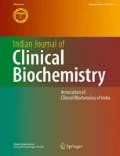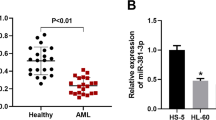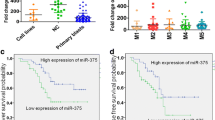Abstract
Acute myelogenous leukemia (AML) is a complex blood malignancy leading to immature leukemic stem cells (LSCs) proliferation. T cell immunoglobulin mucin-3 (TIM-3) is known as a biomarker of AML LSCs. Several microRNAs (miRNAs) can affect gene expression in AML. In this study, the silencing effect of miR-133a-5p on TIM-3 expression in AML cell lineage (HL-60) was investigated. It’s been hypothesized that miR-133a-5p may suppress the TIM-3 expression in AML cell line. Initially, miRNA-TIM-3 prediction, enrichment, and network analysis were done. Then, miR-133a-5p mimic was transfected into HL-60 cells. The TIM-3 protein and gene expression were measured by flow cytometry analysis and real-time PCR, respectively. MTT assay was also carried out. Based on the Bioinformatics predictions, miR-133a-5p was able to silence TIM-3 expression. Also, significant pathways pertained to miR-133a-5p were obtained using enrichment analysis. According to this, miR-133a-5p was mainly engaged in the MAPK signaling pathway and Nicotine addiction pathway using the KEGG database. The TIM-3 protein expression of the transfected cells was measured as 17.15 ± 8.87% (p = 0.001). A 52.48% significant gene silencing in mRNA level was obtained in comparison to the negative control. Despite of down regulation of TIM-3, HL-60 cell viability has not been significantly changed. It has been finally confirmed that miR-133a-5p could strongly suppress TIM-3 expression in AML cell line. Presumably, down regulation of TIM-3 could affect MAPK and Nicotine addiction signaling pathways.




Similar content being viewed by others
References
Shipley JL, Butera JN. Acute myelogenous leukemia. Exp Hematol. 2009;37(6):649–58.
De Kouchkovsky I, Abdul-Hay M. Acute myeloid leukemia: a comprehensive review and 2016 update. Blood Cancer J. 2016;6(7):e441.
Jan M, Chao MP, Cha AC, Alizadeh AA, Gentles AJ, Weissman IL, et al. Prospective separation of normal and leukemic stem cells based on differential expression of TIM3, a human acute myeloid leukemia stem cell marker. Proc Natl Acad Sci USA. 2011;108(12):5009–14.
Kikushige Y, Shima T, Takayanagi S-I, Urata S, Miyamoto T, Iwasaki H, et al. TIM-3 is a promising target to selectively kill acute myeloid leukemia stem cells. Cell Stem Cell. 2010;7(6):708–17.
Kikushige Y, Miyamoto T. TIM-3 as a novel therapeutic target for eradicating acute myelogenous leukemia stem cells. Int J Hematol. 2013;98(6):627–33.
O’Brien J, Hayder H, Zayed Y, Peng C. Overview of microrna biogenesis, mechanisms of actions, and circulation. Front Endocrinol. 2018;9:402.
Cho WC. MicroRNAs in cancer-from research to therapy. BBA Rev Cancer. 2010;1805(2):209–17.
Wiemer EA. The role of microRNAs in cancer: no small matter. Eur J Cancer. 2007;43(10):1529–44.
Cho WC. OncomiRs: the discovery and progress of microRNAs in cancers. Mol Cancer. 2007;6(1):60.
Fooladinezhad H, Khanahmad H, Ganjalikhani-Hakemi M, Doosti A. Negative regulation of TIM-3 expression in AML cell line (HL-60) using miR-330-5p. Br J Biomed Sci. 2016;73(3):129–33.
Emamdoost F, Khanahmad H, Ganjalikhani-hakemi M, Doosti A. The miR-125a-3p inhibits TIM-3 expression in AML cell line HL-60 in vitro. Indian J Hematol Blood Transfus. 2017;33(3):342–47.
Gong Y, Ren J, Liu K, Tang L-M. Tumor suppressor role of miR-133a in gastric cancer by repressing IGF1R. World J Gastroenterol. 2015;21(10):2949.
Dong Y, Zhao J, Wu C-W, Zhang L, Liu X, Kang W, et al. Tumor suppressor functions of miR-133a in colorectal cancer. Mol Cancer Res. 2013;11(9):1051–60.
Akanuma N, Hoshino I, Akutsu Y, Murakami K, Isozaki Y, Maruyama T, et al. MicroRNA-133a regulates the mRNAs of two invadopodia-related proteins, FSCN1 and MMP14, in esophageal cancer. Br J Cancer. 2014;110(1):189.
Wang L-K, Hsiao T-H, Hong T-M, Chen H-Y, Kao S-H, Wang W-L, et al. MicroRNA-133a suppresses multiple oncogenic membrane receptors and cell invasion in non-small cell lung carcinoma. PLoS ONE. 2014;9(5):e96765.
Ji F, Zhang H, Wang Y, Li M, Xu W, Kang Y, et al. MicroRNA-133a, downregulated in osteosarcoma, suppresses proliferation and promotes apoptosis by targeting Bcl-xL and Mcl-1. Bone. 2013;56(1):220–6.
Luo J, Zhou J, Cheng Q, Zhou C, Ding Z. Role of microRNA-133a in epithelial ovarian cancer pathogenesis and progression. Oncol Lett. 2014;7(4):1043–8.
Cui W, Zhang S, Shan C, Zhou L, Zhou Z. microRNA-133a regulates the cell cycle and proliferation of breast cancer cells by targeting epidermal growth factor receptor through the EGFR/Akt signaling pathway. FEBS J. 2013;280(16):3962–74.
Acknowledgements
We greatly acknowledge Department of Research at University of Isfahan, Isfahan, Iran for their collaborations.
Funding
This study was performed at the University of Isfahan and Isfahan University of Medical Sciences and financially supported by the Graduate office of University of Isfahan, Isfahan, Iran.
Author information
Authors and Affiliations
Corresponding author
Ethics declarations
Conflict of interest
The authors declare that they have no conflict of interest.
Ethical Standards
The experiments comply with the current laws of the country in which they were performed.
Additional information
Publisher's Note
Springer Nature remains neutral with regard to jurisdictional claims in published maps and institutional affiliations.
Electronic supplementary material
Below is the link to the electronic supplementary material.
Rights and permissions
About this article
Cite this article
Hojati, Z., Ganjalikhani-Hakemi, M., Ameri, M. et al. Evaluation of Silencing Effect of miR-133a-5p Mimic on TIM-3 Expression in AML (HL-60) Cell Line. Ind J Clin Biochem 35, 359–366 (2020). https://doi.org/10.1007/s12291-019-00834-z
Received:
Accepted:
Published:
Issue Date:
DOI: https://doi.org/10.1007/s12291-019-00834-z




